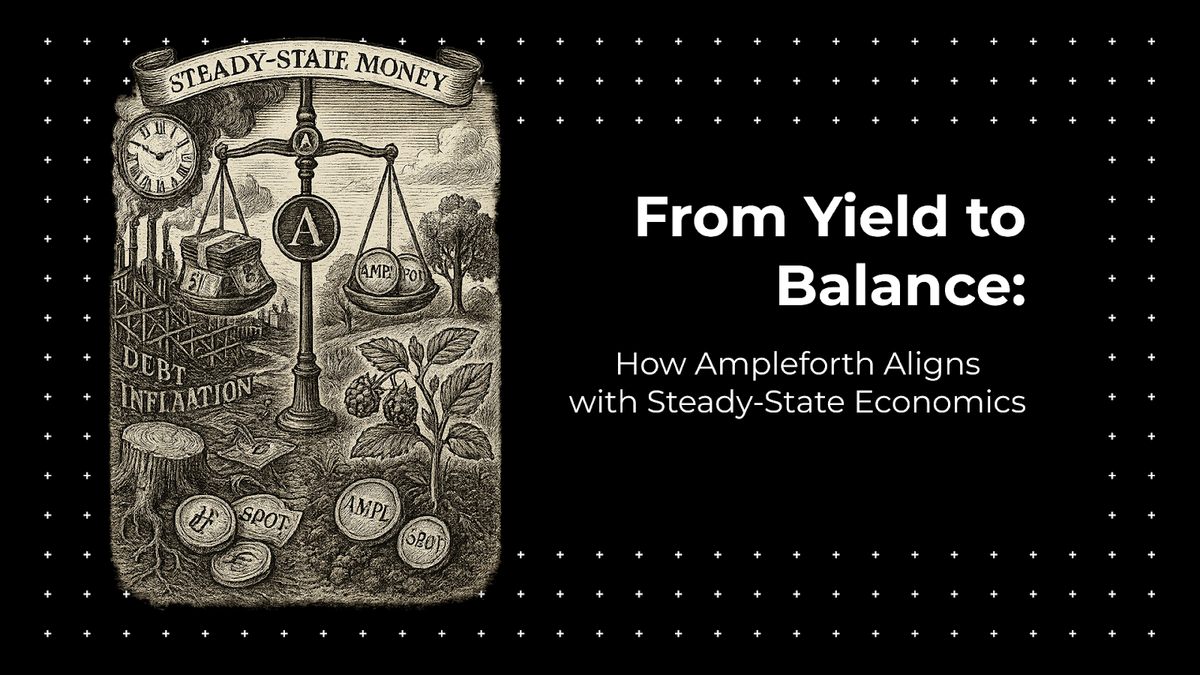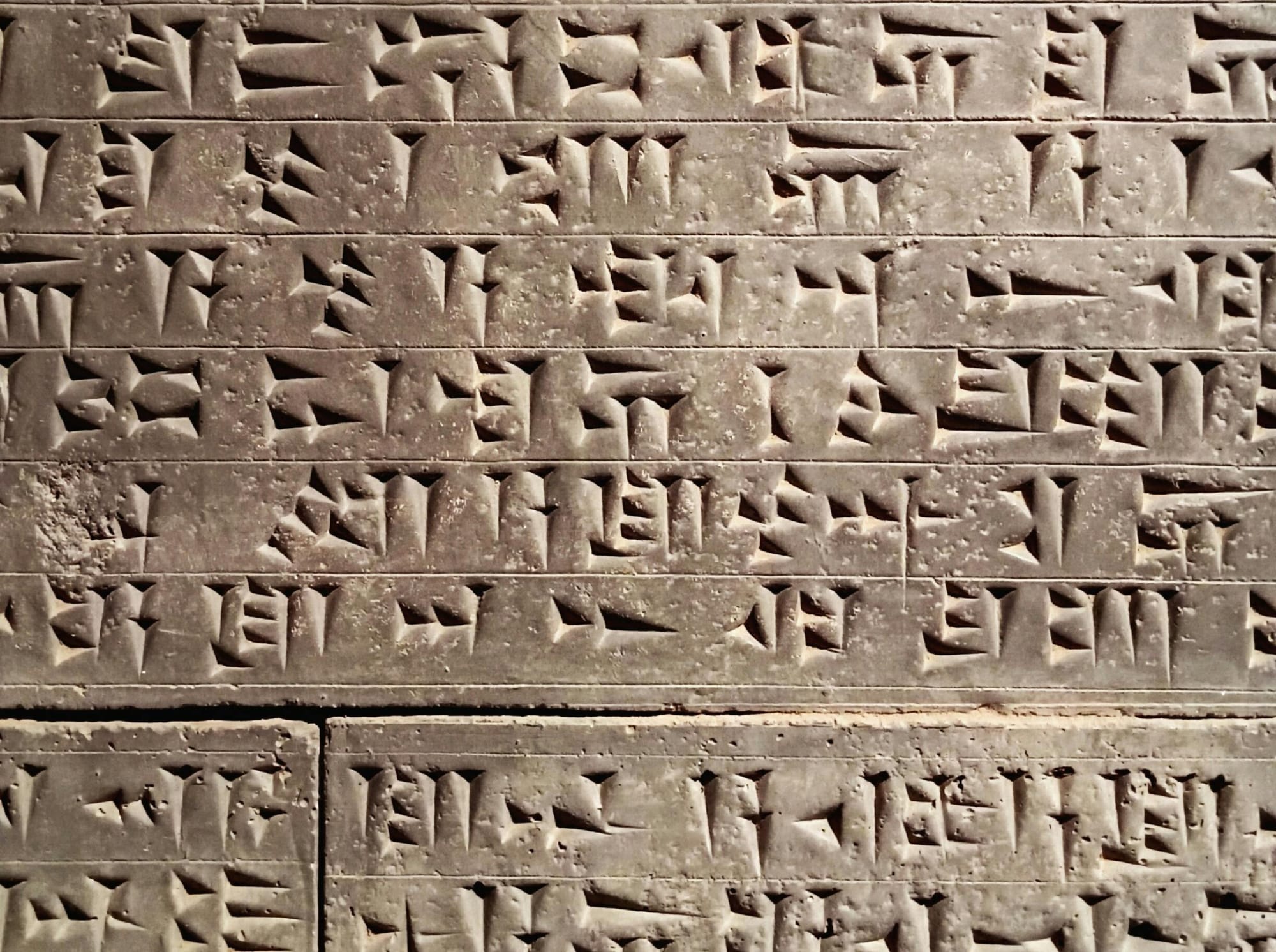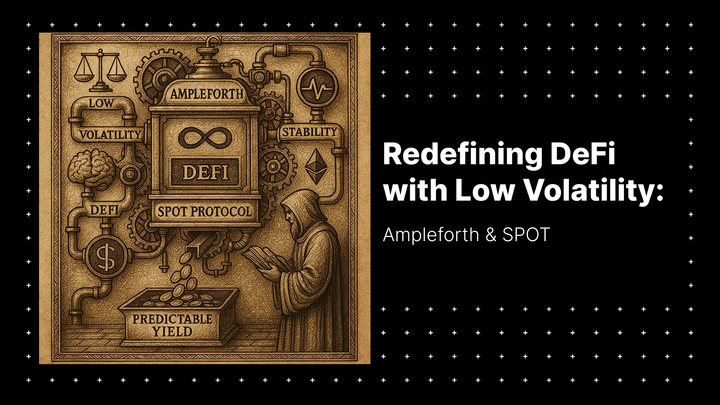From Yield to Balance: How Ampleforth Embodies Steady-State Economics in DeFi

With the advent of agriculture, ten to twelve thousand years ago, man began to control the yield of his basic necessities, and surplus came on the scene. Before this, the cycles of nature determined his provision. ‘Wen moon?’ Every 28 days, fam. When we started to be in charge of yield, we wanted never-ending more of everything and would stop at nothing to get it.
Hunter-gatherers tracked game and migrated with the seasons, following herds, fruit flushes, and nut harvests. They were highly exposed to feast and famine. The good times were great, and the bad times were deadly. Agriculture fundamentally changed that and was the true beginning of the centralization of resources, power, and information.
‘Civilization’ is a misnomer, as civility is not actually a tenet, but vast ‘high’ societies, hierarchy, cities, luxury, and slavery all exploded out from this epochal sea change.
Abstract thought is one of man’s greatest blessings and curses. Abstract value consensus, the genesis of ‘trust me, bro’ has enabled glorious art and architecture, as well as fueled endless wars and facilitated horrifying destruction of man and nature.
From Mesopotamian Usury to Roman Debasement
Yield and inflation have gone hand in hand for the last 5000 years. Yield or interest, depending on which side of the equation one is on, jumped off in Mesopotamia around 3000 BCE. Rates were beautiful for lenders and brutal for borrowers: 20-33% APRs denominated in barley. The first real land ownership structures solidified at this time. The ‘haves’ blossomed like flower petals from the roots of the laboring ‘have-nots’. Two for me, one for you.
The yield quest led Mesopotamians to wantonly cut down trees in a fragile ecosystem, over-graze the land ( they even cut down date palms and pistachio trees to raise goats and sheep!), and salinate the Earth with inefficient irrigation practices, leaving it a desert to this day.
Around 80% of all Mesopotamian cuneiform tablets are economic in nature, with 50% dedicated to finance, debt, and tracking of ownership. This was the advent of single ledger accounting, a completely permissioned and trust-based system.

Agriculture made all this possible. Surplus grain, land, and livestock were the first real stores of value and units of account. Intrinsic value can be rationally considered to be that which supports biological life’s continuance. Before this, trade was settled in the moment, with groups trading commodities and then going their separate ways. Medium of exchange was anything anyone perceived as valuable: stone or metal tools ( also an early store of value), salt, dried meats and fish, leather, and so on. No trust was needed in bartering commodities.
Where once the needs of humanity were provided for across vast landscapes in sync with the rhythms of nature, farming centralized calories and the means to generate them, making multi-year storage of food possible. This allowed individuals, peoples, and societies to hoard resources and subjugate others.
Rome kicked off the first widespread monetary debasement. Facing its decline after a long, blood-spattered run, they cut their denarius coin's silver content from 90% to 5%. Where endless expansion ( read ‘yield’) is concerned, there may well be no ‘too big to fail’. Spoiler alert: Rome fell, but, good news, bro, the Lambo perseveres. They Gucci.
We’re still cutting down highly diverse and decentralized subsistence-providing forests to grow monocrops, centralizing wealth to a select few- running that Fertile Crescent becomes desert playbook. Mass deforestation to graze cattle in the Amazon is the most egregious contemporary example. Flame on! Brazil can't samba that way forever, though; dust never sleeps. Indigenous cultures, generally living in equilibrium with nature, remain the centuries-old externalized cost of the yield chase.
From Mutual Indebtedness to Coinage: the War on Homeostasis
David Graeber, in Debt: The First 5000 Years, reports that early agricultural groups had decentralized small-community debt-based systems. This was a distributed accounting where everyone knew what everyone else owed. I give you a pig, everyone knows about said transaction, and you give me something later on to roughly balance it. This made everyone want everyone else to do well so that they could keep the indebtedness/ paying back cycle flowing. In this schema, debt keeps the society game going; exchanging exact monetary amounts ends the game/ relationship. Graeber writes that conquering armies, tired of carrying all kinds of stuff around to eat, began charging taxes to producers of food, payable in silver ting-a-ling. Plot twist: the plebs had to get the coins from the army by trading food for them. Harsh, dude. Markets were forged where they previously didn't exist.
Strong-arming pre-money societies to essentially give resources to the proof of violence network forced abstract value consensus down their throats. Insult to injury: debasing the coinage was a concurrent scam run by the knuckle sandwich servers. Sound familiar? Don’t mess with the classics. Thus goes every fiat currency system in the world since forever.
Endless Externalized Costs
The notion that abstract value consensus, AKA ‘money’, can do work separately from physical reality has benefited a few and harmed many. The addiction to endless yield has us cutting down trees that we ‘might need’ in the future, for we don't even know what. Probably you need a new kitchen and bath every 3 years, no? Companies churn out e-waste, selling their old R&D phones every 10 months rather than the most updated piece they have. China has built large, speculation-fueled ghost cities with almost no one living in them. Big Red holds at least $7b in unwanted garments in its warehouses to boot. In Ireland, it's said, “Enough is plenty”. Not so in the finance markets. ‘More’ is the only driver.
Yield has to come from somewhere. A common phrase in investing is “if you don’t know where the yield comes from, you are the yield”. Stolen internet user data, poisoned ecosphere, bodily health decline, and soul-crushing jobs are just a few of our modern externalized costs. Expansion-at-all-costs, nationalized, centralized, and manipulated money has brought humanity to a precipitous place.
In many crypto systems, the yield users receive is in part (or in total) inflation of the token’s supply, diluting holders. This is modern-day, digital coin edge shaving, classically known in debasement studies as ‘clipping’. In this way, ‘you are the yield’.
The Genius of Nature
Man’s first conceptual understandings mirrored nature’s movements. Agriculture and the quest for ever-increasing yields led us to make straight lines, right angles, and desert cemeteries. Our conceptualizations, partially out of raw necessity, are returning to this millions-of-years-old source of efficient design. It’s high time to make a new way.
In recent years, biomimicry has emerged as the leading edge of design principles in human creation. The Ampleforth protocol functions with a type of biomimicry, expanding under favorable conditions, and contracting under less favorable ones, like a berry patch. More water and sunlight yield more berries, flowers, branches, and baby plants. When there are fewer of these vital elements, there’s less expansion.
Ampleforth grows when market demand requires it to. Price fluctuations cause the number of protocol tokens to increase/ decrease. This change happens via a transparent, rules-based mechanism called 'rebasing'. In contrast, standard assets simply go up or down in price. Once a day, the protocol supply adjusts, targeting the purchasing power of the 2019 US dollar. For a primer on the evolutionary monetary policy of the Ampleforth protocol:

Ecological economist, Herman Daly, posits a system not based on debt or driven past ecological carrying capacity. It’s called steady-state economics, and while it may seem a far way off, Ampleforth strides in the direction of its forward-looking vision. Decoupling money from nationalized abuses and control is a big first step.
Steady-state economics posits a world in which money is not expansionary at its core, eschewing debt-fueled growth and its resultant neurotic consumption. Adam Smith, the father of modern economics, and John Stuart Mill, 19th-century philosophical luminary, both critiqued the market-borne, base accumulation of resources as an end. Rather, markets are seen as a means, guiding humanity towards free time, enjoyment of life, morality, and self-improvement. Man has too long prized possessions and luxuries over free time, creativity, quality time with family, health, and peace of mind. We are, however, slowly realizing our millennia-old misstep.
Sample this high-level thesis on the long history of steady-state concepts from the University of Vermont:
https://www.uvm.edu/~jfarley/Festschrift/Ch%2018%20Victor.pdf
Or, a lovely and accessible video from the PhD Dan O'Neill:
The Ampleforth Epoch
Centralized, arbitrary control over money has never ended well. From kings recalling coins to shave their edges off and reissue more silver circles weighing less, wars to pay debauchery-fueled nation-state debts, fiat debasement via balance sheet issuance, and all levels of fractional reserve trickery, money is in need of an overhaul. Great news, team Ampleforth is on the job.
F. A. Hayek, Nobel Prize-winning economist, was a devout believer in the truth generated by free markets. He suggests that fiat inflation distorts markets away from the inherent reality they reveal, skewing the swarm intelligence of decentralized demand calculations.
AMPL is always right where it needs to be, free of smoke and mirrors. It's always fully circulating and without debasement. Five years running, denationalized, decentralized, and fully transparent at all times, it is a symphony of simplicity- a perfect blend of monetary and nature-inspired expression. Ampleforth doesn’t inflate; it expands and contracts based on real demand. There aren't emissions, promises, or manipulations, just openly verifiable, triple-entry accounting truth.
Ampleforth’s transparent rules, distributed through governance with the FORTH token, and code is law core, point the way towards a new era in man’s abstract value consensus. It expands only as required by the diffuse computational mind of the market. Hayek, ardent proponent of denationalized monies, is jiggity-jigging somewhere.
For another take on Ampleforth's construction:

As a true, and perhaps arguably the only, Decentralized Finance primitive, the AMPL token has neither yield nor inflation baked into its code. It is an uncollateralized financial tide. There’s no one to owe any yield to. Ethereum is the blockchain upon which AMPL surfs. Its ETH coin is also considered a DeFi primitive, but it inflates, with the potential for it to be deflationary due to usage, a monetary policy 'maybe'. Bitcoin’s supply increases daily, though with a hard cap on its supply. It’s deflationary only when someone loses their private keys or hard drive.
ETH has widely fluctuating prices due to mutable emissions based on centralized coin holdings, developer desires, and standard value accrual mechanics. There is only one perfect unit of account- AMPL. If you hold 1% of the AMPL supply at a 20 million dollar valuation, you'll hold 1% of the supply at a billion dollar valuation. If you borrow 1 AMPL when the protocol is worth $40m, you owe 1 AMPL when it is worth $40b. Borrowing BTC, a store of value, at $100k and having to pay it back at $140k invalidates it as a unit of account.
A Balanced Digital Economy
Ampleforth mimics nature. When a blackberry bush has favorable conditions to grow, it expands by sending underground runners and dropping aerial branch ends into the soil to make new network nodes, expanding the patch. With the right conditions, this hardy forest edge procession plant produces seed-bearing fruit for bird dispersal, protecting the reforesting process with its thorned arches. If there is a dry season or shade has grown up around the patch, the blackberry scales back expansion, storing energy in its roots, awaiting the return of required resources. These plants are never extractive- rather, they synergize and magnify, with no yield demanded of them.

Perhaps humans were never in homeostatic equilibrium with nature. The annual respectful, sacred, and ceremonial hunt of a mammoth with an 18-month gestation slowly made them extinct over generations without anyone even being able to notice. Slash-and-burn agriculture was not net damaging to the environment when bands of people were small and spread out, but mammoths are gone, and our population has exponentiated.
We need to think and rethink deeper, softer, and clearer. Good news, Evan Kuo and Brandon Iles cooked and pondered for years with Stanford PhDs until they baked the cleanest, leanest, clearest unit of account ever seen. A few moons later, they launched SPOT, the premier low-volatility asset and a store of value for the digital age, decoupling money’s three uses with blockchain technology. But that’s a tale for another time.
Our standard economic systems, seeking endless growth above all else, have used trickery, bribery, and violence to create artificial demand for processed foods, plastic goods, and services harmful to both consumer and nature.
We can do better. Ampleforth does better. Reimagining money with clarity towards equilibrium, expanding only with demand, AMPL flows with natural market rhythms and leads us through the Fourth Turning It's a revolution toward rational, open, and fair money. It’s not exactly steady-state, but it's leading the way towards new and balanced horizons for humanity.






